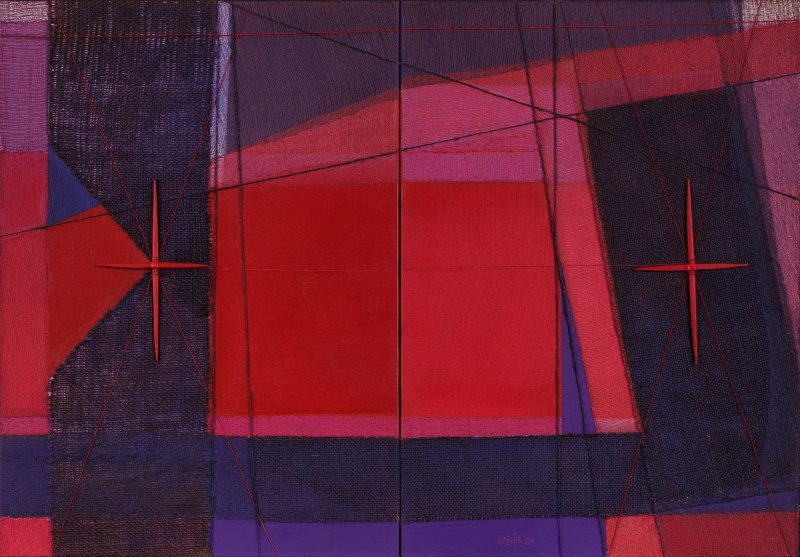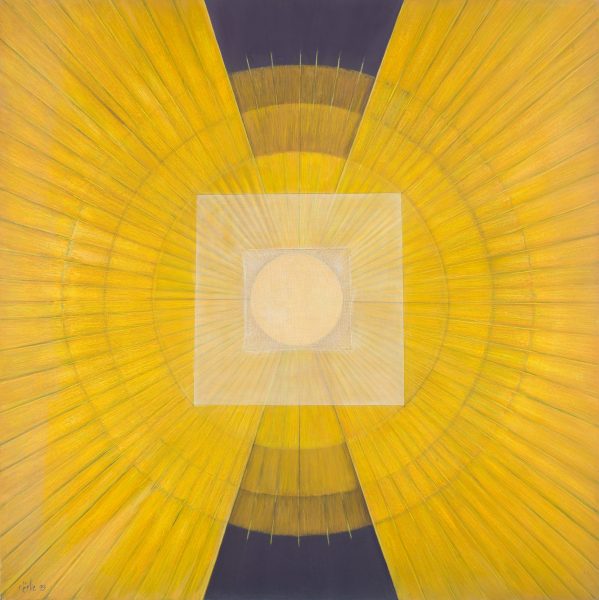The exhibition by Martha Vértiz (San Pedro de Lloc, 1940 – Lima, 2022) is a reencounter with Peruvian visual arts from the sixties. She studied at the Catholic University until 1963 and did not graduate —she did not need it—, which reveals the reasons why the PUC never incorporated her into its activities, despite surpassing most of the graduates. .
Martha was an active part of the currents that developed in Peru in those years and it was common to see her in contests, in parks and in galleries. In 1974 she did her first solo on Trapeze.
In those years he developed a very rich material painting, in the form of emerging walls stained by color. But it was the 70s and the revolution was underway. His investigation into textures alternated with mountain landscapes and still lifes that were part of his concerns: “They were parallel processes… In my painting what matters is non-figuration.”
We became friends in the early eighties and I did several previously unpublished interviews with him that will be incinerated with me due to their content. I put emphasis on our friendship because I admired her a lot. She was intelligent, thoughtful, and spiritual.
We lived through the bustle of the 80s, with the transavantgarde, postmodernity, Lyotard, Eco, Oliva, Hughes, et al. Lucidity was difficult in the midst of the storm, however she took it upon herself to maintain it. She told me that the concept of art does not change, what varies are its languages. And she questioned the historical moment in which we lived. “Certainly time is an important factor… but great art never gets old. That’s why I don’t believe in the instant item because it tends to expire and eventually disappear.
At that time, she began a series of investigations with assemblies in fabrics, seams, needles, and tensions that could be the best feminine emblem of Peruvian art. She worked in a process parallel to that of Sonia Prager —a great sculptor— who had notable drawings with similar concerns. Each one in her own way, differing in their ways of seeing and doing. The parallel was shown in 1997 when Trapecio brought them together in a memorable exhibition.
A decade earlier (1987) I organized an early anthology of Martha Vértiz in the Sala Miró Quesada and the following year, in the now-defunct Oechsle Gallery, the remaining part was exhibited. After 25 years of graduation, there was enough material to study an essential artist.
Then came the geometric derivation, far from any minimalist fashion. The flat colors, the predominance of the design, the elegance in the composition and —why not say it— the mysticism that can be seen in his most outstanding works.
But the medium is relentless with austerity and discretion. Despite her excellence, the last solo show by Martha Vértiz, in 2002, was not a sales success in this environment of cosmopolitan frivolities.
And despite the misunderstanding of collectors/decorators, this work was and continues to be so vibrant that I am sure that a correct review —the current sample is not— will allow an appropriate reassessment. As it happened with Regina Aprijaskis, for example, but in another note. However, I refuse to believe that in Peru an artist must die to be recognized.

Away from the market for the last two decades, she dedicated herself to painting in her studio, reading and watching movies, but mainly in theaters, which limited herself to the films she recommended. An indefatigable reader, I remember the last books I lent her because they reveal her position towards art. The first, about Nahui Olin, a fiery Mexican next to whom Frida Kahlo would look like a cloister novice, did not excite her. The second, on Hilma af Klint, a great Swedish artist rescued, in part, by the predecessors of the MeToo. I had seen the retrospective at the Guggenheim and immediately thought of Martha for her spiritual approaches.
In 2022 I stopped seeing her. He only agreed to communicate by phone. And she died quietly before the year was out. We never said goodbye and that was better. In a place in my memory it is still alive.
II
This show has a long history. Originally Alberto Servat —ICPNA— commissioned it to Elida Román. Later I took the initiative, but it was too late. Her body—and her soul—could not withstand the thrill of an event of this magnitude. Upon her death, Jorge Villacorta proposed to do a retrospective based on the works that he had left behind.
Concluding his curatorship, Villacorta held a sit-in at the door of the Miró Quesada along with the artists who participated in trilce. And the mayor of Renovación Popular vetoed it, acting like a raging bull against all shades from red to pink and more. His controversial eternity in CANATUR may explain his current outbursts.
The protest was inappropriate. If what the mayor represented was so outraged, they must have withdrawn BEFORE the end of the exhibition. In addition, so much curatorial bitterness is inexplicable at a time when he was in charge of another sample for the same management.

The result was predictable. Only the work of Martha Vértiz is saved in the middle of a decrepit space, with semi-destroyed floors, without baseboards or air conditioning, without panels or humidity control, and terrible lighting that highlights the walls over the paintings.
That decadence, which they impudently call the Miraflores Palace of the Arts (PLAM), is not suitable for exhibiting art. The mayor knows it well. He may argue that there are no resources —there are never for culture— but it cannot be postponed to close to recondition and avoid huachafería in a space —not a palace— under his responsibility.
Other shortcomings are also insulting. The ex-curator should have been required to make a minimum selection of works that would not dilute the correct appreciation. The erratic editing demanded a museographer and not an improvisation without a script. And, despite what has been said, the work is there, luminous and lonely. Like the life of an exceptional woman.
(Luis Lama).
Unforgettable plastic artist Martha Vértiz – Caretas Cultura
